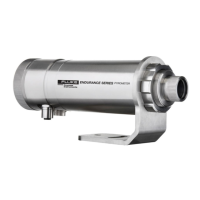The following order shows the priorities of possible failsafe conditions starting with the lowest priority.
1. narrow band temp. over range (lowest priority)
2. narrow band temp. under range
3. wide band temperature over range
4. wide band temperature under range
5. two-color temperature over range
6. two-color temperature under range
7. attenuation>95% (dirty window)
8. attenuation too high (> 95%)
9. energy too low
10. narrow band detector failure
11. wide band detector failure
12. internal temperature under range
13. internal temperature over range
14. heater control temperature under range
15. heater control temperature over range (highest priority)
Examples:
1. 1-color temperature is selected to show on the temperature display. 2-color temperature is transmitted in
burst mode. Wide band temperature is under range. The 2-color temperature is 999°C.
Outputs:
Temperature display: EUUU
Digital interface: C T999.0
Analog output: 2 to 3 mA
Relay: abnormal state
2. 2-color temperature is selected to show on the temperature display. All three temperatures are transmitted
in burst mode. Two-color temperature is 1021.0°C. Wide band temperature is 703.0°C. Narrow band
temperature is 685.0°C. Attenuation is above 95%, the “dirty window” threshold.
Outputs:
Temperature display: 1021.0
Digital interface: C T1021.0 W703.0 N685.0
Analog output: scaled to temperature, between 4 and 20 mA
Relay: abnormal state

